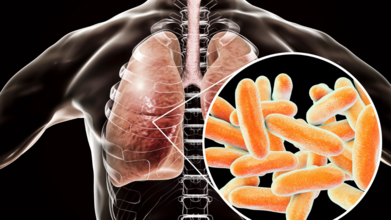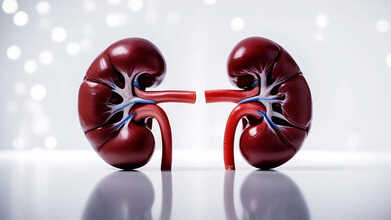- Health Conditions A-Z
- Health & Wellness
- Nutrition
- Fitness
- Health News
- Ayurveda
- Videos
- Medicine A-Z
- Parenting
- Web Stories
Legionnaires' Outbreak Update: It Is No Longer 'Only A New York Problem'

Credits: Canva
Legionnaires’ disease first came to public attention in 1976 after an American Legion conference in Philadelphia led to dozens of pneumonia cases caused by a then-unknown bacteria. Scientists later identified it as Legionella, a bacteria that naturally occurs in freshwater but typically remains harmless in small quantities.
Problems arise when stagnant, warm water systems, from cooling towers to pipes, provide fertile ground for the bacteria to multiply and release into the air.
Once inhaled in contaminated mist, the bacteria can cause a dangerous form of pneumonia that kills about one in ten infected patients. The Centers for Disease Control and Prevention (CDC) estimates that most cases in the U.S. are linked to potable water systems.
New York’s Current Outbreak
This summer, New York City has recorded its largest outbreak in years, with more than 100 people sickened and at least five deaths. Officials have traced the source to a cluster of contaminated cooling towers in Central Harlem, including one at Harlem Hospital. Heavy July storms are believed to have filled these towers with rainwater that went untreated, allowing bacteria to spread.
The incident has already triggered lawsuits against contractors and raised questions about whether city inspections are keeping pace with the threat. Just 1,200 cooling towers were inspected in the first half of 2025, a sharp decline from 2017 when more than 5,000 were checked in the same period.
Not Just a New York Problem
While the outbreak has grabbed headlines in New York, public health researchers emphasize this is not an isolated concern. Cases of Legionnaires’ have been climbing steadily across the United States, Canada, and Europe.
Read: Unique COVID-19 Like Symptoms Of Legionnaires' Disease And How Long Does The Infection Last
The Environmental Protection Agency (EPA) warns that warmer temperatures and increased rainfall are making conditions across the country more favorable for Legionella.
Communities that never needed large-scale cooling systems are now installing them to combat rising heat, creating new risks. Even modern “green” buildings can unintentionally increase exposure. Low-flow plumbing systems, designed to conserve water, can allow it to sit stagnant in pipes, encouraging bacterial growth.
Climate Change Accelerates the Spread
Summers have always been peak season for Legionnaires’, but climate change is intensifying the problem. Warmer air, higher humidity, and extreme rain events are combining to create perfect breeding conditions. Flooding adds another complication, as contaminated water can more easily infiltrate public water supplies.
European health agencies have already warned that climate change is likely to expand the range of Legionnaires’ disease. In the United States, rising cases mirror these predictions, suggesting the New York outbreak may be just one of many to come.
Unequal Burden on Vulnerable Communities
As with many climate-linked health threats, low-income neighborhoods often suffer most. Poorly maintained cooling towers are more likely in underfunded housing complexes, and chronic health issues common in these areas, such as asthma or diabetes, make residents more vulnerable to severe illness.
Harlem, the center of New York’s outbreak, highlights this intersection of infrastructure neglect and health inequality. Experts caution that without stronger oversight and better maintenance of public systems, similar communities nationwide could become hotspots for future outbreaks.
What Individuals Can Do
For most people, preventing Legionnaires’ on an individual level is difficult, since the bacteria spreads through community water systems and airborne mist. Still, health officials advise paying attention to public health alerts, especially if you are over 50, smoke, or have chronic conditions that weaken the lungs or immune system.
During outbreaks, residents can consider using high-quality water filters or ensuring home cooling systems are regularly cleaned. But the most critical step remains recognizing symptoms early. Fever, cough, and shortness of breath should prompt immediate medical attention, as antibiotics are highly effective when treatment begins quickly.
A Public Health Responsibility
Experts stress that Legionnaires’ disease cannot be managed through individual vigilance alone. The real solution lies in better maintenance of large-scale water and cooling systems, more consistent inspections, and infrastructure upgrades that account for a warming world.
Unique Symptoms of the ‘Unpleasant’ Winter Bug Spreading in UK, NHS Issues Alert

Credits: Canva
Health officials in the UK have issued a 48-hour warning after a rise in cases of an “unpleasant” winter bug. The UK Health Security Agency (UKHSA) has urged people to stay home for two days after symptoms subside to help stop the spread of norovirus, commonly known as the “winter vomiting bug.” The virus, which causes vomiting and diarrhoea, spreads easily, particularly in colder months.
Recent data shows that cases have started to climb across England in recent weeks. The NHS has supported the UKHSA’s advice, reminding people to remain at home for at least 48 hours after symptoms clear to avoid infecting others.
What Is The Winter Bug Spreading In UK?
Norovirus is a highly contagious group of viruses that cause sudden vomiting and diarrhea. It spreads easily through contaminated food, water, and surfaces, and is known to peak during the colder months. In fact, it’s the leading cause of foodborne illness in the United States.
The virus was first identified in 1968 after an outbreak in an elementary school in Norwalk, Ohio, which gave it its original name, the Norwalk virus.
Norovirus vs. the Stomach Flu
Although often called the “stomach flu,” norovirus is not related to influenza. The flu virus affects the respiratory system, while norovirus targets the digestive tract, causing gastroenteritis.
Types of Norovirus
Norovirus belongs to the Caliciviridae family and includes 10 groups with around 48 known types. Among these, the GII.4 strain is the one most often linked to widespread outbreaks.
Unique Symptoms of Norovirus
Here are some less-covered but important unique symptoms of Norovirus infection to watch for:
- A sudden, intense onset of vomiting and watery diarrhoea, often without warning.
- Rapid loss of appetite and stomach cramps that may begin only 12 to 48 hours after exposure.
- Feeling unwell with low-grade fever, head or body aches, chills or muscle pain that accompany the GI symptoms.
- Signs of dehydration early on, such as dark urine, dry mouth, faintness on standing, or crying with few or no tears especially in children, older adults or immune-weakened people.
Unusual how quickly it hits and how short-lived it often is: many people recover in 1-3 days, yet they can still spread the virus for days after symptoms stop
To help stop the virus from spreading, the NHS has urged people with symptoms to take extra care, as per NHS. Those affected should:
- Avoid going to work, school, or nursery until at least 48 hours after their last episode of vomiting or diarrhoea.
- Refrain from visiting hospitals, care homes, or other vulnerable settings during the same period.
- These precautions are crucial because norovirus remains highly contagious even after symptoms appear to have cleared.
How to Stop Norovirus from Spreading
Contaminated food and water can also transmit the virus. Along with staying home while you’re unwell, the NHS recommends taking the following precautions to reduce the risk of passing it on:
Wash your hands thoroughly with soap and warm water after using the toilet or changing nappies, alcohol-based hand gels do not kill norovirus.
- Clean your hands before handling food, whether you’re cooking, serving, or eating.
- Launder soiled clothes and bedding separately at 60°C if they’ve come into contact with vomit or stool.
- Disinfect frequently touched surfaces, including toilet seats, taps, flush handles, and door handles.
- Limit physical contact with others until you’ve been symptom-free for at least two days.
Hyderabad Faces Surge in Mysterious Kidney Disease Among Healthy Youth, Study Finds

Credits: Canva
A chronic kidney disorder of unknown origin, referred to as Chronic Kidney Disease of unknown etiology (CKDu), is leading to kidney failures in Hyderabad and nearby districts of Telangana, alarmingly affecting younger adults who are economically active and have no prior history of diabetes or high blood pressure.
A team of senior nephrologists from Osmania General Hospital (OGH) and Apollo Hospitals studied 75 patients and published their findings in the Indian Journal of Nephrology (August 2024). The study revealed that while the disease resembles the mysterious kidney failures reported in Andhra Pradesh and other states, it shows a distinct, city-specific pattern of risk in Hyderabad.
Mysterious Kidney Disease In Hyderadabad
A mysterious kidney condition, called chronic kidney disease of unknown etiology (CKDu), is increasingly being reported among younger, non-diabetic residents in Hyderabad and nearby districts of Telangana, a study led by nephrologists reveals. Unlike traditional CKDu cases, which are often associated with agricultural work and heat exposure, this urban group largely comprises small business owners and service-sector workers with no farming history.
“Our research confirms the presence of the CKDu phenotype in Telangana, beyond the established hotspot regions, showing that an agricultural background is not required for the disease to develop,” said Dr. Manisha Sahay, Head of Nephrology at OGH and lead author of the study.
While CKDu in other regions is typically linked to strenuous farm labor and heat exposure, clinical data from OGH indicate that different, non-occupational factors may be driving the disease in younger, economically active individuals with no farming history. The condition progresses silently, often only producing symptoms once the kidneys are severely damaged, making urgent treatment at hospitals like Osmania General Hospital necessary.
What Is Chronic Kidney Disease Of Unknown Etiology?
Chronic kidney disease of unknown etiology (CKDu) is a type of chronic kidney disease with no identifiable cause, commonly observed in agricultural communities in certain regions. It is believed to arise from multiple factors, including environmental exposures such as pesticides, heavy metals, heat stress, dehydration, and contaminated water. According to the International Society of Nephrology, CKDu is diagnosed when known risk factors for chronic kidney disease, such as diabetes and hypertension, are absent.
What Are The Possible Causes Of Chronic Kidney Disease Of Unknown Etiology?
While the exact cause of CKDu is not confirmed, researchers suggest several possible contributors. The disease is likely multifactorial, arising from a combination of factors rather than a single cause. Environmental toxins, including heavy metals, pesticides, and mycotoxins, are under investigation. Heat stress and repeated dehydration from strenuous work in hot climates may also damage kidney tubules. Other potential factors being studied include contaminated water supplies and viral infections.
Kidney biopsies of patients at OGH revealed widespread scarring and inflammation in the kidney’s filtering units, indicating that the disease starts silently in this critical compartment.
“The damage observed in these biopsies highlights the severe consequences of late diagnosis, a pattern seen consistently across all CKDu-affected regions. Since the disease remains largely asymptomatic in its early stages, patients often reach urban hospitals only when they urgently need dialysis or renal replacement therapy,” said Dr. Manisha Sahay, Head of Nephrology at OGH.
CKDu in Hyderabad Linked To Urban Lifestyles and Unregulated Herbal Remedies
“While globally, 60 to 80 percent of CKDu cases occur among agricultural workers, only 21.3 percent of the Hyderabad patients were involved in rice farming,” noted Dr. Manisha Sahay in the study. “This shows that the CKDu phenotype affects a broad range of individuals from non-agricultural backgrounds, including small business owners, service-sector employees, and urban residents.”
Adding to the concern, 40 percent of patients in the OGH study reported using unregulated alternative or herbal medicines. Researchers emphasize that this widespread local practice may represent a significant risk factor, highlighting the need for urgent public health investigations targeting local dispensaries and providers of traditional remedies.
Hand, Foot And Mouth Disease Strikes U.S. Day-Cares: What Parents Must Know

Credits: Canva
Health authorities have reported an active outbreak of hand, foot and mouth disease in Tennessee, impacting close to 200 children and staff members across multiple schools.
In its latest update on Monday, October 20, the Shelby County Health Department confirmed that 178 cases have been identified among students and staff in 31 schools and three daycare centers.
What Is Hand, Foot And Mouth Disease?
Health officials in Tennessee have issued a warning about a “highly contagious” illness spreading through several schools and childcare facilities.
The Shelby County Health Department confirmed in a recent statement that an outbreak of hand, foot and mouth disease (HFMD) has been detected across 31 schools and three childcare centers in the state.
According to the Centers for Disease Control and Prevention (CDC), hand, foot and mouth disease is a contagious viral infection that typically leads to fever, mouth ulcers, and a skin rash. Although it most often affects children under the age of five, people of any age can contract it. Symptoms usually persist for about a week to ten days.
The CDC explains that the virus spreads easily through droplets released when an infected person coughs, sneezes, or talks, as well as through contact with contaminated objects, surfaces, or fluid from blisters.
Symptoms Of Hand, Foot And Mouth Disease
Hand, foot and mouth disease (HFMD) usually develops in two stages. In the beginning, children often experience mild, flu-like symptoms such as a low fever, sore throat, runny nose, stomach discomfort, and loss of appetite. These early signs typically subside after a few days, followed by the appearance of an itchy rash on the palms, soles, elbows, knees, or buttocks, along with painful mouth sores that may form on or around the tongue, as per Cleveland Clinic.
These sores usually start as small pink spots before turning into blisters, and some children may also develop swollen lymph nodes in the neck. Most cases clear up within a week to ten days, though recovery can take longer in children under two years old.
What Causes Hand, Foot And Mouth Disease?
The illness is caused by viruses from the coxsackievirus and enterovirus families, which are commonly found in the mouth and digestive tract. HFMD is highly contagious, especially in the first few days of infection and often before the rash appears. While the blisters usually dry up within ten days, the virus can linger in stool for several weeks, meaning children may still spread it after symptoms have disappeared. The infection spreads through droplets released when an infected person coughs or sneezes, through direct contact with saliva, stool, or fluid from blisters, and by sharing utensils, cups, or towels. It can also spread by touching contaminated toys, surfaces, or doorknobs and then touching the mouth, nose, or eyes.
The Shelby County Health Department stated that it has been working closely with schools and childcare centers to track the outbreak and reduce the spread of the infection.
Dr. Bruce Randolph, Director and Health Officer of the department, noted that while most cases of hand, foot and mouth disease are mild, the virus can spread rapidly in group settings such as classrooms and daycare facilities. He advised parents to keep affected children at home until their fever has subsided, they are feeling better, and their mouth sores or blisters have started to heal.
© 2024 Bennett, Coleman & Company Limited

